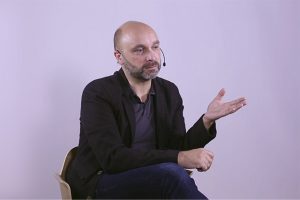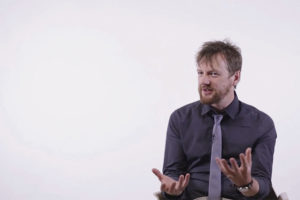Hot and Cold Cognition
Neuropsychologist Barbara Sahakian on risky decision-making, two forms of cognition that people use, and the ...

Working memory is a system that provides an interface between the environment and various aspects of the mind. It is a type of memory that allows us to hold information in mind while we are working on it. Working memory also allows information to be combined from perception and long-term memory, and short-term memory.
The term ‘Working Memory’ was first introduced as a term in a book by George A. Miller, Eugene Galanter, and Karl H. Pribram, but they did not elaborate on it. It was then used by Richard Atkinson and Richard Shiffrin in their very influential model of short-term memory. But they did not actually stress the functional part of it. Graham Hitch and I did so in our revision of their model. Our model differs from theirs in, first of all, assuming that short-term memory can be fractionated into subcomponents and, secondly, emphasizing the fact that it is a system that allows complex cognition and invites investigation on that basis. Atkinson and Shiffrin proposed that it played this role, but they did very little to investigate it. When we began to do so, we found that their model was too simple, and we had to elaborate on it.
The initial model had three components. The first component was an attentional control system, which we called the central executive, and this was helped by two temporary storage systems: one, a verbal and acoustic system, which we eventually came to call the phonological loop, and the other, its visuospatial equivalent, the visuospatial sketchpad. Subsequently, we had to add a fourth component which brings together the three components and links them to perception and to long-term memory and also acts as the basis of conscious awareness.

The central executive is certainly the most important and the most complex component of the original three. It is an attentional system that has a limited processing capacity. It is also used in other areas, and it is central to our understanding of intelligence as a concept and complex cognition in general. The executive is fed by two temporary storage systems. The system that Graham Hitch and I have studied the most extensively is the phonological loop. It can hold information in a speech-based or sound-based form and can maintain it by subvocal rehearsal, by saying it to yourself. Evidence for this comes from a number of sources. One is the phonological similarity effect. If you are trying to remember a string of items and they are similar in sound, then they tend to be confused, and performance is poor. For example, if we ask a person to remember a string of words like ‘pit, day, cow, hot, sun’, he or she can remember those fairly easily, but if the words are similar in sound, like ‘man, cat, cab, hat, can’, performance drops very substantially.
What we have is a little encapsulated system where we can maintain information by saying it to ourselves. Saying it to yourself can be demonstrated by having people remember five long words, such as ‘refrigerator, university, diphtheria, rhinoceros, opportunity’ / With five long words, people then can get it right only about 50% of the time, as opposed to 90% with monosyllables. So we have this little encapsulated system which is not so important for understanding speech if you are a fluent listener or speaker. It is important for acquiring vocabulary and for the earliest stages of learning to read. So it is a useful system when you need to hold sequences of sounds in the right order.
The visuospatial equivalent is called the sketchpad. It holds both visual and spatial information, which have been shown to be different types of information. Visual information concerns things like shape and color, whereas spatial information contains information about the location. So using a map involves spatial information while learning a symbol for a Chinese word which is a much more visual task. Remembering a color is more visual, and designing a building is more spatial. We now think that both visual and verbal temporary memory systems are fed from other streams of information. So in the case of the phonological loop, people have shown that sign language in the deaf uses this rather than the visuospatial system so that tasks that interfere with verbal phonological memory also interfere with both sign language and lip reading. In the case of the visuospatial system, you have different visual and spatial streams and probably also tactile, while tactile itself involves separate receptors for sensations of heat, touch, and pain.
Hence each case involves a series of perceptual streams that bind together and then feed into the fourth system, which is the episodic buffer. This is where streams of information can be combined. To do so, the buffer is assumed to have multiple dimensions. It is visual and spatial, it is semantic and perceptual, and it pulls all these things together and makes them available to conscious awareness. As such, it lies at the heart of consciousness. When I first proposed the idea of an episodic buffer, I thought that it was likely to be a highly active system that would manipulate information. Experiments that we have done in recent years suggest that this is not the case. What it does is act as a passive screen on which can be projected the result of binding and manipulation that has been performed offscreen, consciousness. We do not think it depends on one specific area of the brain but rather that it is the result of a number of brain systems working together. It does, however, require a level of basic consciousness, so if you have a knock on the head or you are asleep, your episodic buffer is not likely to be working fully. Thus the episodic buffer is somewhat like the stage on which everything happens or a screen on which events are projected.

Working memory is located in many parts of the brain. In the case of the phonological loop, principally on an area between the temporal and parietal lobes of the left hemisphere, the process of rehearsing them involves a more frontal area, sometimes known as Broca’s area; damage to this area can also result in the disruption of fluent speech. The visuospatial system principally involves the right hemisphere, but it also extends to areas in the occipital lobes towards the rear of the brain. This area is involved in visual imagery, while more medial parietal areas are responsible for spatial processing. However, the fact that these are activated does not necessarily mean that this is where the information is stored. One of the problems in attempting to use functional imaging to understand working memory is that it is largely correlational; it simply says, ‘this area is active’, but it does not say whether it is actually necessary for the cognitive tasks being studied. There is, for example, an interesting contrast between people who say that they have very vivid visual imagery and people who say they have none. Both of them do as well as each other on visual memory, but they report quite different experiences and probably have different areas of the brain that are activated. So it is as if you are accessing information from a central computer store, and you can retrieve information either on the screen or through a spoken version. What is important is what is stored; how it is displayed is interesting but should not be confused with where it is stored.

The system used to be called short-term memory, which emphasized its temporal aspect, suggesting that the crucial question was how long it lasts before the stored information is passed to long-term memory. It does not work like that at all. Short-term memory is being maintained for a long time if you are not thinking about anything else. Furthermore, long-term memory can start as rapidly as short-term with the two running in parallel, rather than long-term operating only as a later processing stage.
Long-term memory also comprises a series of separable systems that differ, although all are involved in storing information for longer periods than working memory. Within long-term memory, there is a major distinction between what is called explicit or declarative memory and implicit or nondeclarative memory. Declarative memory is what we normally think of as remembering, recalling that you saw someone yesterday or remembering that the capital of France is Paris. In contrast, non-declarative memory involves using stored information to perform tasks implicitly rather than by actively remembering. It is typically indicated by changing the way in which you perform some action or activity. We would often describe this as learning rather than memory, as in learning a skill such as how to ride a bicycle. Other implicit memory effects can operate over a much shorter period of time. For example, if I read out a series of words and then ask you to identify them when spoken in a noisy environment, you will show better performance on the words that you have just heard without realizing why. Indeed this effect is shown in patients who are densely amnesic and are totally unable to remember that they have just heard these or, indeed, any such words.
If you give such amnesic patients a word and afterward you say, ‘Have you seen that word?’, they will say no. However, if you give them the first few letters and ask them to guess a word that fits, then they will guess correctly to the same extent as will healthy people showing that something has been learned though it can not be explicitly remembered. Patients also will show a form of hedonic or emotional learning. If you present someone with an unfamiliar type of music, for example, Korean music, people initially find it unpleasant, but when they have heard it a few times, then they will like it more. Amnesic patients also show this effect, though denying ever having heard it before. There are many such learning systems that operate implicitly and are not impaired in amnesic patients. They also differ in a number of ways from explicit memory for events or facts in healthy people. Such systems vary in nature but have in common that they do not depend on conscious monitoring for their operation.

The explicit or declarative system can be divided into two broad categories. One is called episodic memory, and it is the capacity to directly recall or recognize specific episodes or events that have happened in the past. So remembering where you went on holiday last year, for example, by remembering a holiday in Russia, or indeed remembering what I had for breakfast this morning. All of these allow you to remember a specific event or memory, and in order to do that, you need to have it cataloged in a way that will allow you to access that particular memory, what you ate this morning, for example, not just what you usually eat. So you need a filing system, and you need a way of finding that particular memory within the file. Now the way in which episodic memory works is by associating the memory to the context in which it occurred, effectively “gluing” it to the environment, the time and place where it was experienced. If you provide part of, for example, where I experienced it, then it can bring back memories of the event that happened there. Similarly, if you remember somebody’s name, it will bring back that person. Because this type of memory depends on the capacity to glue experiences together, it is fragile. Unfortunately, it deteriorates as you get older and is grossly impaired in amnesic patients.
In a much-quoted paper, George Miller proposed a capacity of seven chunks of information, what he termed his “magic number”. This is often taken to mean that we can remember seven items, such as a seven-digit telephone number. The most important aspect of his paper, however, is not that the capacity is seven, but the concept of a chunk, whereby several items can be combined into a single chunk, for example, a word rather than a set of letters. This also operates at the word level allowing span to increase from about five unrelated words to around 15 words if they form a meaningful sentence allowing meaningful phrases to act as chunks words can be. Over the years, the assumed capacity of working memory has reduced, with the current estimate assumed to be around three or four based on extensive research by Nelson Cowan.
The phonological loop can be disrupted in people who have damage to the left hemisphere to areas responsible for language. Sometimes, however, patients whose language is well preserved may have grossly impaired short-term verbal memory, where their ability to repeat back an unfamiliar telephone number is limited to two digits. They do not rehearse because this would feed information into a faulty short-term store. Other patients may have disruption to aspects of the visuospatial sketchpad. Yet, in other cases, the central executive is impaired, typically as a result of damage to the frontal lobes. This can lead to major problems in organizing their lives, in planning and, in autobiographical memory with unreliable recall and to problems in checking the resulting memory, leading to confabulation. One patient, when he was home from the rehabilitation center, turned to his wife and said, ‘Why do you keep telling people we are married?’ she replied, ‘But we are married; we have got three children!’; at that time it would be very unusual to have three children and live together if you were not married. When he denied this, she got out the wedding photographs, to which he said, ‘Well, that chap does look like me, but it is not me because I am not married.’. An hour later, he no longer claimed this. He was not just making a joke because his behavior would also show confabulation. On one occasion, he was seen taking a fellow patient in a wheelchair up the road outside of the rehab center. When he stopped, he said he was taking his friend to see the sewage works he was working on as an engineer. He had built such a system many years before, but very far away, and he could not possibly walk there.

So the frontal lobes are important for generating and checking memories. The problem of retrieval can be shown through the simple task of trying to recall the names of as many animals as possible in 90 seconds; most people will come up with a dozen or more. Our patient said, ‘Dog… there must be thousands of them… Did I say dog?’ He had not lost the knowledge, and when I asked him for the name of an Australian animal that hops, he immediately replied, “Kangaroo”. His problem was controlling his memory search. The frontal lobes are important for many other tasks involving executive control, including performance on intelligence tests. And severe damage to both frontal lobes can be very disabling.
There are certain claims that working memory can be trained, and some training programs do improve performance levels on the tasks trained. And on different tasks that are broadly in the same category. What people have not demonstrated is that this improvement will generalize to such educationally relevant activities as learning maths, improving reading, or performing on intelligence tests. It remains possible that extra training aimed at generalization might allow further educationally relevant applications, but so far, there is little evidence for this.
There are hundreds of open questions related to working memory. The most active current area is in visual short-term and working memory, where a growing number of people have moved into the study of visual working memory from studying visual perception and visual attention. They have so far tended to concern themselves with the earlier stages of visual short-term memory, whereas we ourselves have focused more on the role of attentional control, often using methods that were developed to study verbal working memory.
If I were starting again, I would probably choose to work on the influence of emotion and motivation on working memory. In cognitive psychology, we currently lack a proper concept of mental energy. Cognitive psychology is principally concerned with the control of the action. However, we also need to think about what is being controlled and why we act at all. At an individual level, energy is clearly very important for achievement, and yet psychologists largely neglect it. I see this as a potentially exciting and underinvestigated field.
Edited by Liana Khapaeva

Neuropsychologist Barbara Sahakian on risky decision-making, two forms of cognition that people use, and the ...

Professor of Neurology, Neurosurgery and Biomedical Engineering at McGill University Sylvain Baillet on brain ...

Psychologist Terry Hanley on youth specific mental problems, the need for relocating service places, and impor...